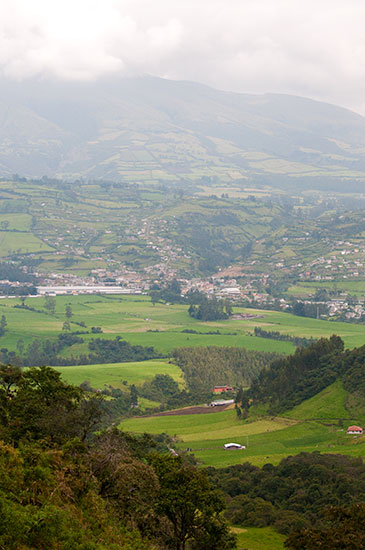| This article is incomplete. This article is missing one or more sections. You can help the BirdForum Opus by expanding it. |
Overview
Lat: 0 26' South Lon: 78 30' W
Pasochoa is an inactive volcano a few kilometers south of the capital city of Quito. It has 500 ha (1250 ac) of the scarce remaining natural forest in the InterAndean valley. It covers an altitude range from 2780 - 4200m (9,174 - 13,860 feet). Pasochoa is visited more by hikers and climbers than by birders. In spite of its small size there have been 127 different species of birds recorded in the area. It has been designated as an Important Bird Area by BirdLife International.
Birds
Notable Species
The Andean Guan and Ocellated Tapaculo are unusually easy to see here. The Giant Conebill is considered vulnerable.
Rarities
Andean Condor, Curve-billed Tinamou, Cinereous Harrier, Aplomado Falcon, American Barn Owl, Great Horned Owl, Andean Pygmy-Owl, Short-eared Owl, Band-winged Nightjar, Rainbow-bearded Thornbill, Equatorial Antpitta
Check-list
Birds you can see here include:
(Bird sightings will vary by altitude)
Andean Guan, Black Vulture, Black-chested Buzzard-Eagle, Variable Hawk, American Kestrel, Band-tailed Pigeon, Eared Dove, Sparkling Violetear, Speckled Hummingbird, Shining Sunbeam, Ecuadorian Hillstar, Buff-winged Starfrontlet, Sword-billed Hummingbird, Great Sapphirewing, Sapphire-vented Puffleg, Black-tailed Trainbearer, Purple-backed Thornbill, Tyrian Metaltail, Blue-mantled Thornbill, White-bellied Woodstar, Crimson-mantled Woodpecker, Stout-billed Cinclodes, Chestnut-winged Cinclodes, Andean Tit-Spinetail, Many-striped Canastero, Pearled Treerunner, Tawny Antpitta, White-banded Tyrannulet, White-throated Tyrannulet, Tufted Tit-Tyrant, Black Phoebe, Vermilion Flycatcher, Streak-throated Bush Tyrant, Rufous-breasted Chat-Tyrant, Brown-backed Chat-Tyrant, Red-crested Cotinga, Blue-and-white Swallow, Brown-bellied Swallow, Rufous Wren, Mountain Wren, Grass Wren, Great Thrush, Black-crested Warbler, Scarlet-bellied Mountain-Tanager, Plumbeous Sierra-Finch, Ash-breasted Sierra-Finch, Plain-colored Seedeater, Gray-browed Brush Finch, Rufous-collared Sparrow, Broad-winged Hawk, Carunculated Caracara, Common Ground-Dove, White-tipped Dove, Chestnut-collared Swift, White-collared Swift, White-tipped Swift, Green-tailed Trainbearer, Bar-bellied Woodpecker, White-chinned Thistletail, Azara's Spinetail, White-browed Spinetail, Streaked Tuftedcheek, Ocellated Tapaculo, White-crested Elaenia, Tawny-rumped Tyrannulet, Black-billed Shrike-Tyrant, Smoky Bush Tyrant, Crowned Chat-Tyrant, Barn Swallow, Plain-tailed Wren, Paramo Pipit, Band-tailed Seedeater, Paramo Seedeater, Grassland Yellow-Finch, Rufous-naped Brush-Finch, Southern Yellow Grosbeak
Other Wildlife
Puma, rabbit
Site Information
History and Use
Due to deforestation, over 90% of the natural forest has been destroyed throughout the inter-andean valley. Because of its inaccessibility and unfavorable location for agricultural use, Pasochoa has remained intact. In 1996, it was established as a protected area and is run by Fundación Natura. It was designated as an important bird area by BirdLife in 1999.
Areas of Interest
Pasochoa is near Cotopaxi National Park, Ilanisas Protected Area and Atacasa, all great birding areas for high altitude avifauna.
Being close to Quito there is an abundance of restaurants, hotels, hosterieas, and other points of interest.
Access and Facilities
Pasochoa is located about 25 km (15 miles) from downtown Quito. The easiest route is to take the PanAmerican Highway south until you reach the village of Tambillo. Once you pass through the town you need to turn onto the road that goes to Sangolqui. About 5 km (3 miles) from this turnoff you will see a sign that indicates the road to Pasochoa. As you turn right onto this road you will see a church about 50 meters ahead. Turn right again in front of this church and travel about 5km to the entrance to the Pasachoa Wildlife Refuge.
Entrance to the reserve costs $10 for foreigners and $2 for locals. You will be given a map indicating the trails that navigate the park. The paths can be ranked from easy to difficult, depending on how high you want to climb on the volcano. Ask the ranger about the condition of the trails as mud slides can sometimes make them impassible. The forest is very dense and you must stay to the paths.
Camping is permitted in the park and their are picnic areas available. The ranger station has books on the avifauna of the reserve. There are clean restrooms at the station.
The reserve is located on the western face of the volcano. Because of this the park does not receive direct sunshine until about 8:00AM.
Contact Details
General Information: natura@fnatura.org.ec
Quito Office: Elia Liut N45-10 y Telégrafo Primero
Phone: (593-2) 3317-457 / 2272-863
External Links
To do




